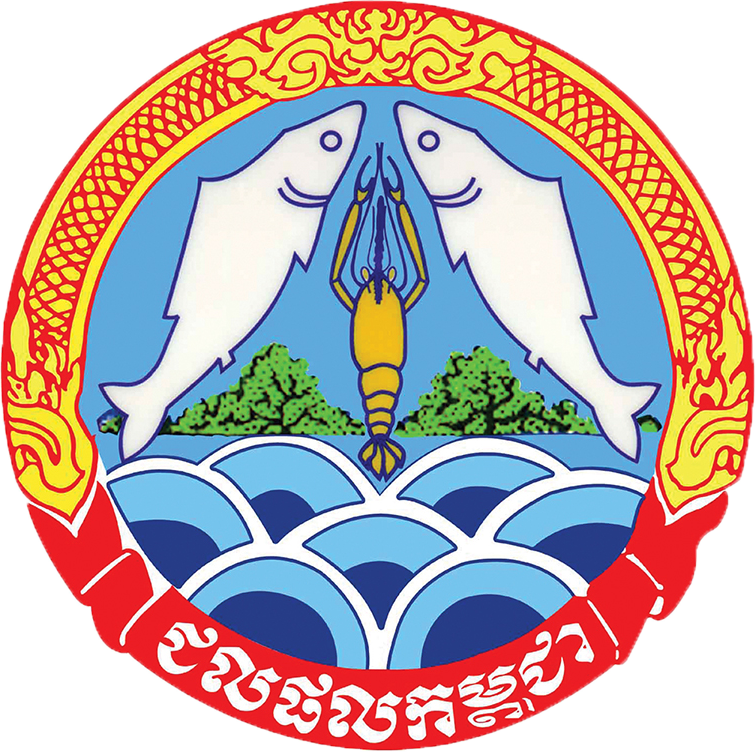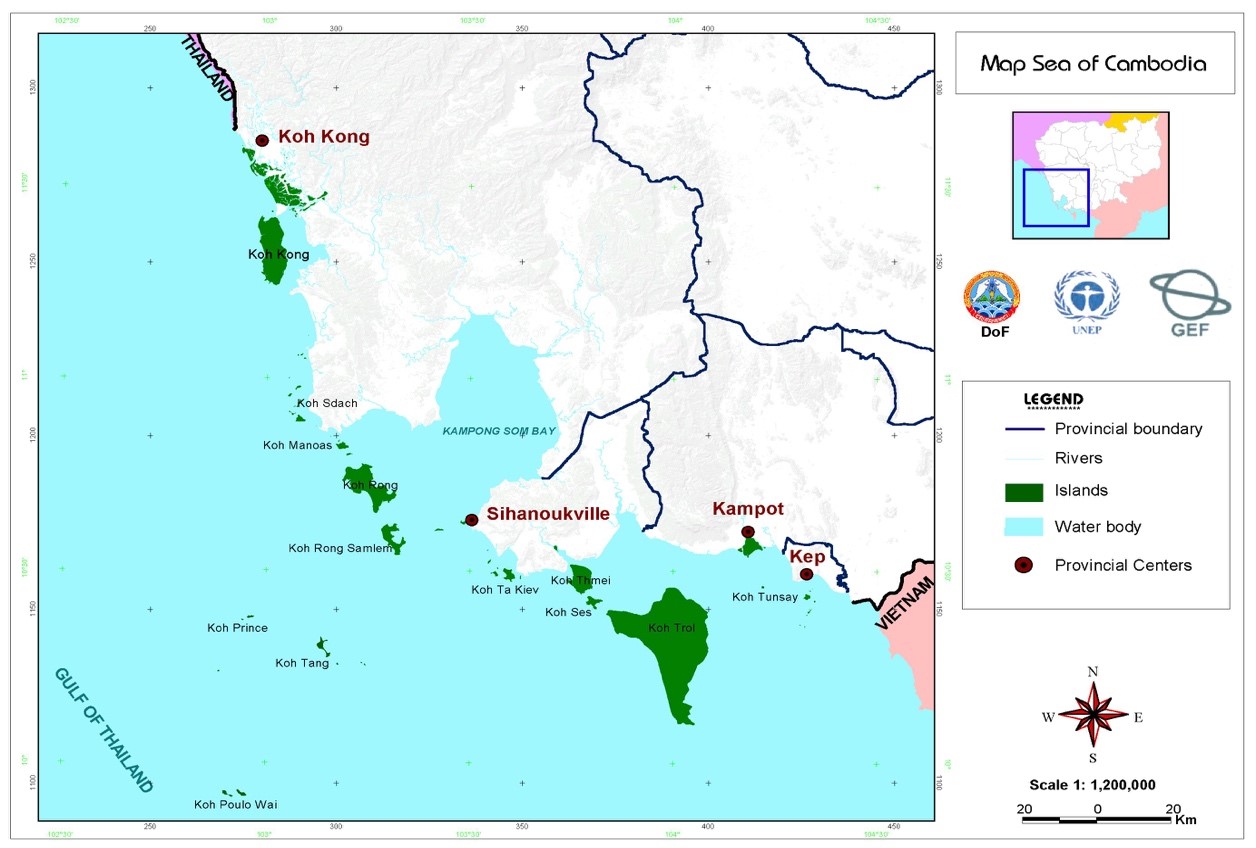Background & Situation Menu
Status and Trends in Fisheries and their Habitats Threats, root causes and barrier analysis Institutional, sectoral and policy context Stakeholder mapping and analysis Baseline analysis and gaps Known Areas of Critical Significance to the Life-Cycles of Fisheries Resources Priority Fisheries Refugia Areas




Establishment of Fisheries Refugia in Cambodia:
Background and Situation Analysis to Support
Status and Trends in Fisheries and their Habitats
Cambodia’s fisheries and aquaculture play an important role in the national economy and contribute to food security. The sector provides employment and economic benefits to Cambodians involved in its activities. Fisheries production is estimated to be worth around US$200-300 million per year at the point of landing and fisheries harvesting, processing and trade contributes 8-12% of GDP. During recent decades however, the productivity of Cambodia’s fisheries resources, including fishes, crustaceans, and molluscs, has declined significantly. This is largely due to increased pressures on fish stocks and their habitats associated with burgeoning coastal populations. Increased demand for fisheries products, and the associated improvements in fishing technology, have contributed to this problem.
Cambodia's fisheries are divided into inland and marine capture fisheries. Inland capture fisheries are significantly more important to Cambodians than marine fisheries, accounting for more than 81 % of Cambodia’s total volume of fish production. In terms of value, however, marine fisheries account for nearly 40 % of the country’s fisheries production. It is important to note that there are significant limitations in the information and data relating to fisheries production as a reliable system for the systematic collection of fisheries information and data has not yet been established in Cambodia. The fact that fish are not landed at central locations, together with direct exports by foreign vessels and other factors, contribute to difficulties. Fish caught by subsistence fisherfolk are often not included in the official statistics, and as such, the statistics do not adequately reflect the importance of fisheries to small-scale subsistence fishing communities in Cambodia.
Cambodia is an ASEAN country bordering the Gulf of Thailand, with a coastline of 435 km extending from the Thai border in the north to the border with Viet Nam in the south. The coastal area of Cambodia is divided into four provinces, Koh Kong, Kampot, Sihanoukville and Kep (Figure 1).

Cambodia’s marine capture fisheries are characterised by a multitude of species and the use of a range of fishing gears. Historical records indicate that fisheries production in Cambodia developed considerably from 1988 when changes to government policy created free market and free election systems. Gradual improvements to information and data collection make it difficult to determine general trends in production, as apparent increases in landings are often simply attributed to the initiation or establishment of more rigorous data collection programmes. Anecdotal information suggests that the average size of many economically important fish species traded in domestic markets is declining.
Many types of small-scale or artisanal, middle-scale, and large-scale fishing gear are used in Cambodia. According to a proclamation made by the Ministry of Agriculture, Forestry and Fisheries, small-scale or artisanal and middle-scale fishing gears are distinguished by the capacity of boat engines and fishing gear size. The term commercial fishery is used only for inland fisheries and is rarely used in relation to Cambodia’s marine fisheries. Marine capture fisheries in Cambodia are divided into two categories, namely middle-scale fisheries and small-scale or artisanal fisheries. Middle-scale fisheries are those utilising highly efficient fishing gear and vessels with capacity to fish both offshore and inshore using a variety of gear types, with the exception of trawling in inshore waters (Table 1). These fisheries are required to pay tax to the government. After the government declared a reform of the fisheries sector in October 2000, middle-scale inland fishers do not have to pay tax. However, fishers operating middle-scale fishing gears in marine waters are required to pay tax as usual, albeit at rates lower than those prior to the government reform.
Table 1. Fishing gears commonly used by middle-scale fisheries in the coastal waters of Cambodia
No. |
Type of Fishing Gear |
No. |
Type of Fishing Gear |
||
English Name |
Khmer name |
English Name |
Khmer name |
||
1 |
Trawl |
Uon Ohs |
7 |
Scomberomorus gill net |
Mong Trey Beka |
2 |
Purse seine/Ring net |
Uon Tith |
8 |
Mackerel gill net |
Mong Trey Kamong |
3 |
Anchovy encircling seine |
Uon Ka Koeum |
9 |
Shrimp gill net or Trammel net |
Mong Bang Kear |
4 |
Beach seine |
Uon Khow |
10 |
Crab gill net |
Mong Kdam |
5 |
Encircling seine |
Uon Houm |
11 |
Horizontal longline |
Santouch Ro Noung |
6 |
Gill net |
Mong Paehk |
12 |
Clupea gill net |
Mong Trey Kbork |
Small-scale fisheries are those utilising traditional and/or passive fishing gear (Table 2), non-power boats, or power boats with a capacity lower than 5 HP. Generally, these fisheries operate in anywhere except in conservation areasand small-scale fishers are not required to pay tax. The relative importance of fishing gear types to fishing communities and fish production has not been investigated in Cambodia, although Table 3 summarises the species typically targeted using different fishing gear types.
Table 2. Small-scale or artisanal fishing gears used in the coastal waters of Cambodia
No. |
English Name |
Khmer name |
No. |
English Name |
Khmer name |
Gill net (Mong Paehk) |
|||||
1 |
Crab gill net |
Mong Kdam |
3 |
Fish gill net |
Mong Paehk |
2 |
Shrimp gill net |
Mong Bang Kear |
4 |
Seabass gill net |
Mong Trey Spong |
Stationary Gear |
|||||
5 |
Squid trap |
Lop Meuk |
8 |
Bamboo crab trap |
Lop Kdam Roeusey |
6 |
Fish trap |
Lop Trey |
9 |
Small winged set bag |
Pong Pang |
7 |
Crab trap |
Lop Kdam |
10 |
Circular net crab trap |
Lop Mong Kdam |
Mobile gear |
|||||
11 |
Push net |
Thnorng Os Ky |
13 |
Drift gill net |
Mong Bandet |
12 |
Hook |
Santouch |
|
|
|
The number of fishing vessels in Cambodian waters fluctuates according to the distribution and abundance of natural resources and broader socioeconomic, market and political conditions. Unfortunately, existing data does not enable the estimation of the number of fishing vessels by the different types of fishing gears used. This is because each fishing vessel may operate more than one type of fishing gear and they change the type of gear used according to the season.
Table 3 . The species targeted by different fishing gears in Cambodia
Fishing gear |
Target group |
Secondary group |
|
English Name |
Khmer Name |
|
|
Mackerel gill net |
Mong Trey Kamong |
Rastrelliger brachysoma |
Rastrelliger kanagurta, Megalaspis cordyla, Thunnus tonggol |
Anchovy encircling seine |
Uon Ka Koeum |
Stolephorus indicus |
|
Shrimp gill net |
Mong Bang Kear |
Penaeus merguiensis |
|
Fish gill net |
Mong Trey |
Scomberomorus guttatus, Thannus thannus, Ariidae thalassinus, Eleuteronema tetradactilum, Liza argentea, Valamugil ceheli, Rastrelliger brachysoma, Rastrelliger kanagurta, Megalaspis cordyla, Formio niger, Lates calcarifer, Dasyatidae |
Serranidae, Lutjajisdae, Nemipteridae, Sciaenidae, Drepanidae, Siganidae, Trichiuridae, Stromatoidae, Chirocentridae and Synodontidae. |
Crab gill net |
Mong Kdam |
Portunus spp., Scylla serrata |
|
Crab trap |
LopKdam |
Portunus spp., Scylla serrata |
|
Squid trap |
Lop Meuk |
Sepioteuthis lessoniana, Loligo spp. |
|
Fish stake trap |
|
Mixed fish species |
|
Horizontal longline |
Santouch Ro Noung |
Orectolobidae, Carcharinidae, Dasyatidae, Serranidae, Lutjanidae |
|
Push net |
Chhep Yun |
Mixed fish, Metapenaeus spp. Sepiolidae, Octopus spp. |
|
Shellfish dredge |
Chhneang os khchorng |
Arcidae, Veneridae |
|
Beach seine net |
Uon Khow |
Mixed fish, Sepiolidae, Loligo spp. |
|
According to the marine fisheries statistics it is estimated that the total volume of marine capture fisheries production in Cambodia is between 30,000 to 50,000 tonnes per year. Seafood from Cambodia is exported to several countries in South-east Asia, including China, Thailand, Viet Nam, and Singapore. Approximately 15 to 25% of the total marine catch is exported annually, almost exclusively as unprocessed (live or chilled) products.
The coastal population of Cambodia is approximately 1 million people. It is estimated that about 40% of these people are engaged full-time in fishing and that 30% fish part time. Most fisherfolk operate at a small-scale or subsistence level and also small farming plots at the household level to meet nutritional needs. The civil war and the Khmer Rouge regime severely disrupted the traditional fishing community system in Cambodia. During this period, coastal and marine fisheries were almost completely abandoned and only rice farming was encouraged. In recent years, there has been a significant migration of poor people from inland rural areas to the coast. These people mostly engage in fisheries because it requires little investment and is open access, although they typically have no experience in fisheries or knowledge of traditional or more contemporary management principles.
Accordingly, the Cambodian fishing fleet is generally low technology, and most vessels operate only in inshore waters on one-day trips. In addition, they use only ice for storing the catch. Social surveys in Kampot province in 2007 indicate that from 700 fisherfolk involved in marine fishing could earn an average monthly income of US$152 depending on their ability, capacity, and financial resources. Incomes are better for fishing communities in Sihanoukville and Koh Kong than those of the Kampot social survey group, due to the availability of wider and more productive fishing grounds. There is very little private sector investment in Cambodia’s marine fisheries, with most vessels operated by the owner and a hired crew.
As in other countries of the Southeast Asian region, fisheries statistics do not provide information regarding the species composition of catches and landings, rather they are sorted by higher taxon. However, based on information provided by Fisheries Administration staff, Cambodian waters are characterised by high levels of species diversity, and that this diversity is similar to that observed for marine areas of other regional countries. Cambodia’s commercially important fish species include about 30 species from the Mackerel, Scad, Anchovy and Snapper groups. Those species are abundant from September to January, whereas the peak period for Penaeus and Metapenaeus shrimps is May-August. Blue swimming crab, squid and cuttlefish are available throughout the year. There is a diverse range of important mollusc species in Cambodia, and the most important commercial species, such as green mussel and oysters are mainly found in the Koh Kong estuary. Blood cockle is abundant in Thmar Sar of Kampong Som Bay and Trapeang Ropov of Kampot Bay. Marine mammals and reptiles, including dugong, sea turtles and dolphins, also inhabit Cambodian waters. Dugong is usually found in sea grass beds of Kampot bay from November to December, whilst a variety of dolphin species are present throughout the year within the region. Sea turtles, especially Hawksbill, Green, and Loggerhead turtles are observed in inshore waters adjacent to nesting beaches.